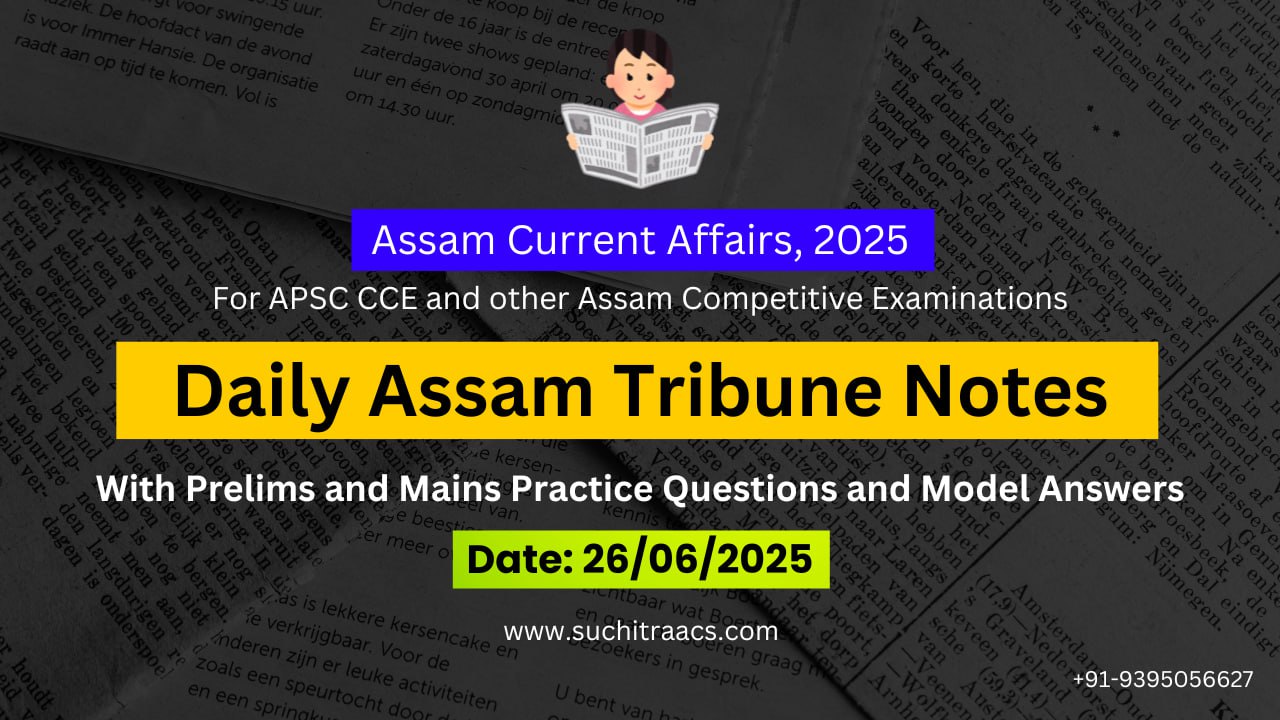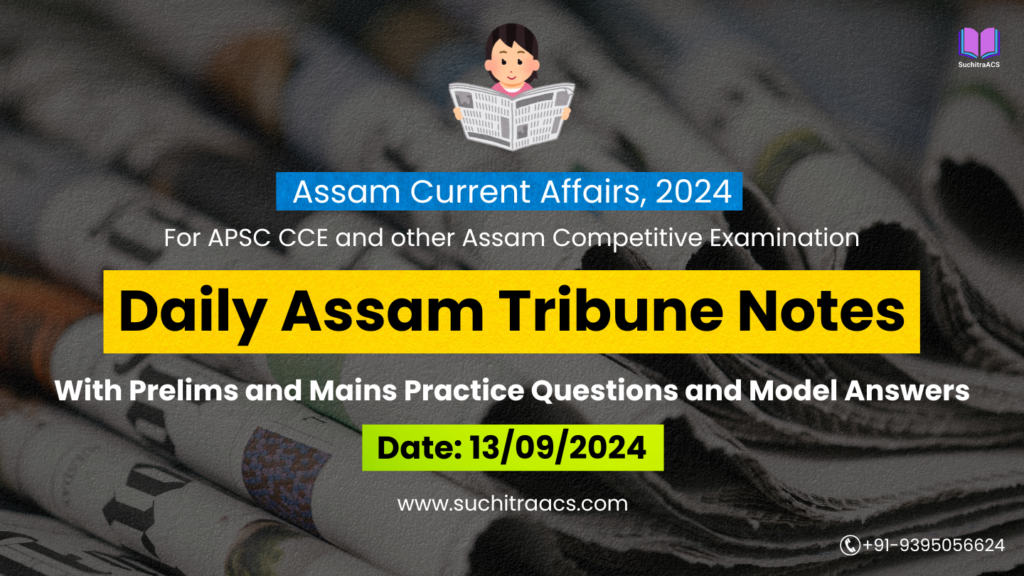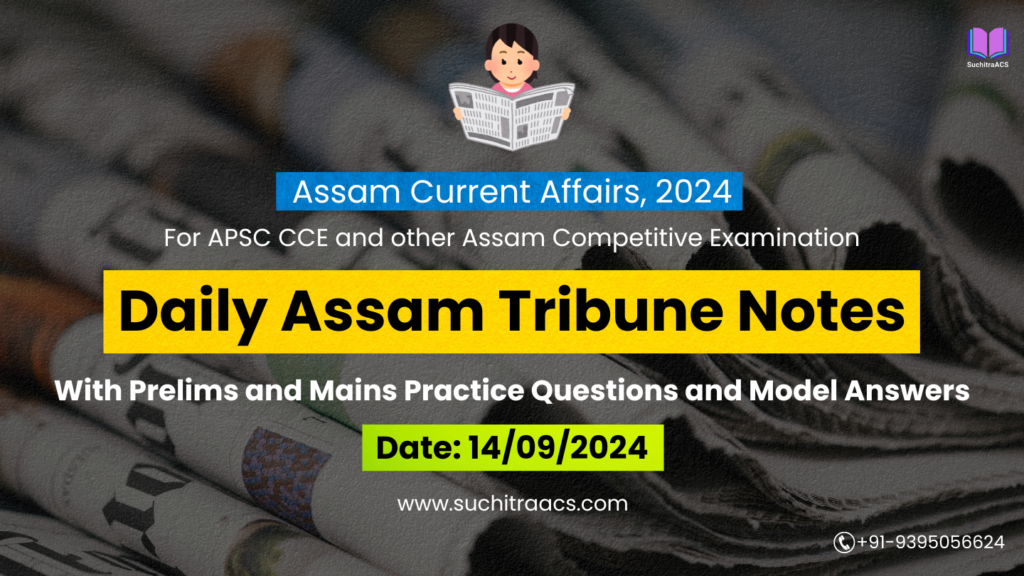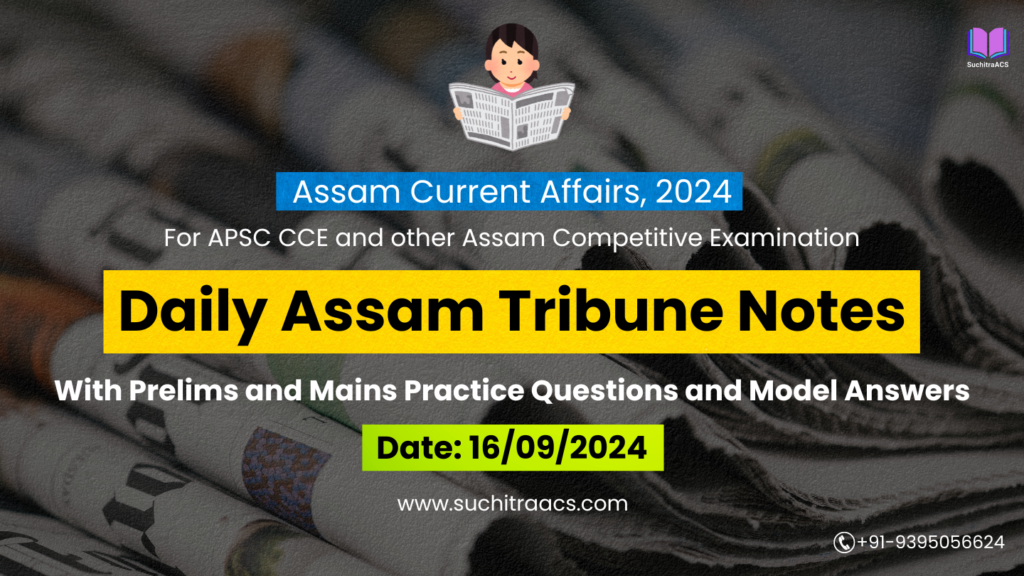APSC Current Affairs: Assam Tribune Notes with MCQs and Answer Writing (26/06/2025)
For APSC CCE and other Assam Competitive examinations aspirants, staying updated with current affairs is vital. This blog covers most important topics from the Assam Tribune today (26-06-2025). These issues are key for both APSC Prelims and Mains preparation, offering insights into the APSC CCE Syllabus.
✨ APSC CCE Online Coaching, 2026
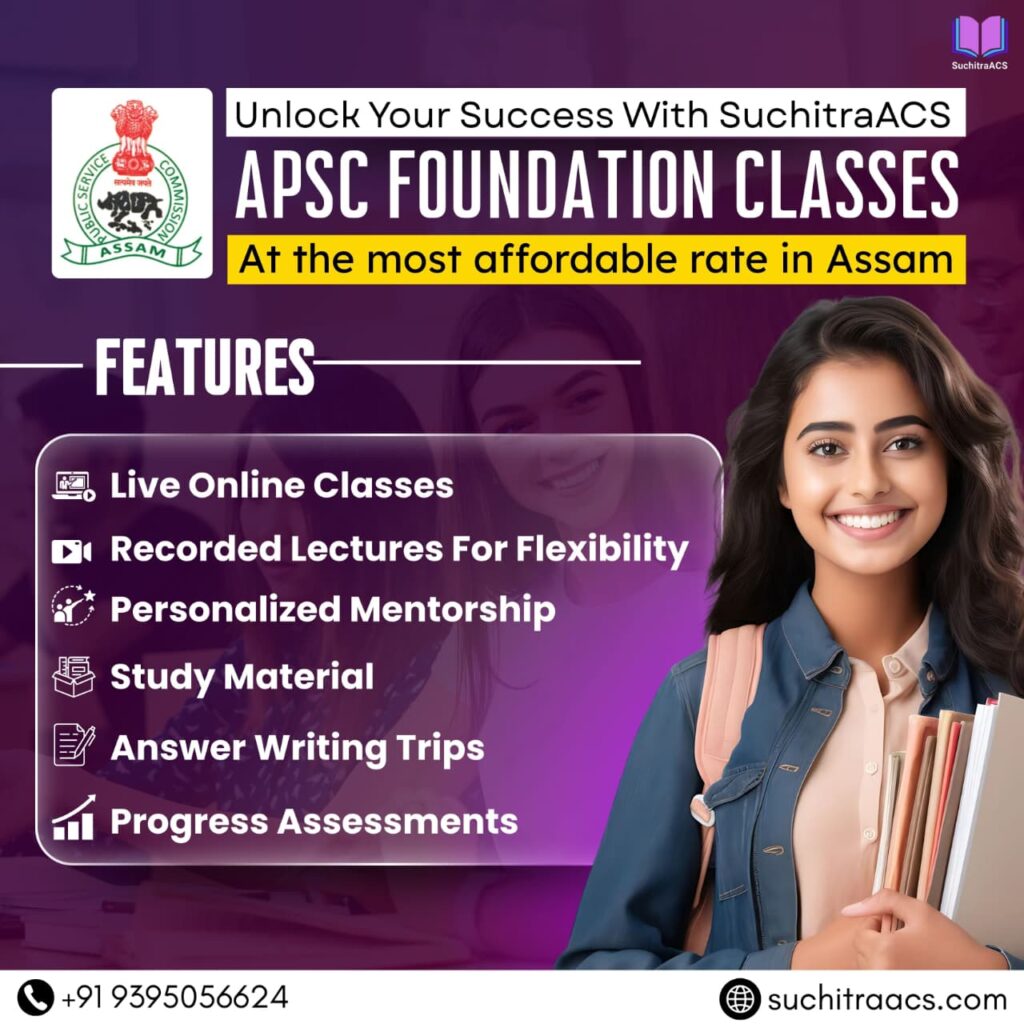
🚀 India’s Return to Human Spaceflight After 41 Years
📘 GS Paper 3: Science and Technology – Achievements of Indians in Space
📘 GS Paper 2: International Relations – Space Diplomacy | Science & Tech Cooperation
📘 APSC GS Paper 5: Assam’s contributions to National Achievements
🔹 Introduction
India marked a historic milestone as Shubhanshu Shukla, an Indian astronaut, boarded a commercial mission by Axiom Space to the International Space Station (ISS). This is India’s first crewed space mission since Rakesh Sharma’s 1984 flight, showcasing India’s renewed presence in human spaceflight on a global platform.
🔑 Key Highlights
| Feature | Description |
| 🚀 Mission Name | Axiom-4 (AX-4) Mission |
| 👨🚀 Indian Astronaut | Shubhanshu Shukla (Lucknow-born) |
| 🛰️ Spacecraft | SpaceX Crew Dragon – Grace |
| 🚀 Launch Vehicle | SpaceX Falcon 9 |
| 🛰️ Destination | International Space Station (ISS) |
| 🧪 Mission Duration | 14 days (science + cultural outreach) |
| 🤝 Partners | Axiom Space (USA), NASA, ISRO support |
| 🌏 Significance | 41 years after Rakesh Sharma’s Soviet mission (1984) |
🧠 Prelims Pointers
Rakesh Sharma: First Indian in space (1984), flew aboard Soviet Soyuz T-11
ISS (International Space Station): Joint program by NASA, Roscosmos, ESA, JAXA & CSA
Axiom Space: US-based private space company pioneering commercial spaceflights
Falcon 9: Two-stage rocket developed by SpaceX; reusable launch system
Gaganyaan Mission: India’s indigenous human spaceflight program (ISRO-led)
📝 Mains Pointers
A. Significance of India’s Human Spaceflight Return
| Aspect | Impact |
| 🌐 Global Collaboration | Highlights India’s growing ties in global space missions |
| 🔬 Science Diplomacy | Projects India as a cooperative space partner in LEO missions |
| 👨🔬 Tech Prestige | Showcases India’s skilled astronautics, contributing to manned missions |
| 🧑🚀 Public Inspiration | Motivates youth to join STEM and space research |
| 🇮🇳 National Pride | Reaffirms India’s vision as a space-faring nation |
B. Challenges in Human Spaceflight
🚧 Technological complexity in life support, docking, re-entry
💰 High financial costs and dependence on foreign tech for now
🌍 Geopolitical balance in engaging multiple space agencies
🛰️ Space debris management and orbital safety
🧠 Astronaut training pipeline still at nascent stage in India
C. Government Initiatives
ISRO’s Gaganyaan Mission – Targeting indigenous crewed space launch
IN-SPACe and NSIL – Promoting private-sector space participation
Anusandhan National Research Foundation (NRF) – R&D support in frontier tech
Draft Space Policy 2023 – Encourages collaboration, commercial launches, startups
📊 Relevant Global Developments
India signed the Artemis Accords (2023) – Boosts cooperation in deep space
Axiom Space Missions – Commercial access to ISS and private station development
Increasing Indian participation in microgravity research, biotech, materials science in space
🧭 Way Forward
| Strategy | Action |
| 🧑🚀 Build domestic astronaut corps | Establish long-term training at ISRO’s astronaut centre |
| 🛰️ Complete Gaganyaan | Launch indigenous mission by late 2025 or early 2026 |
| 🤝 Expand collaborations | Continue tie-ups with NASA, ESA, private players |
| 💼 Boost space startups | Support Indian private space firms under IN-SPACe |
🧩 Conclusion
India’s renewed foray into human spaceflight represents a quantum leap in national capability and aspiration. Beyond prestige, it signals commitment to advanced science, global cooperation, and space exploration leadership. With Gaganyaan and private partnerships on the horizon, India is poised to be a major player in the new space age.
🚨 Six-Lane Expressway Project to Connect Assam and West Bengal via Alipurduar
📘 GS Paper 3: Infrastructure – Roads | Investment Models
📘 GS Paper 1: Geography – Transport & Connectivity in NE India
📘 GS Paper 5 (APSC): Assam – Connectivity | Border Trade | Regional Development
🔹 Introduction
The Union Ministry of Road Transport & Highways (MoRTH) has approved the construction of a greenfield six-lane expressway connecting Barpeta (Assam) to Alipurduar (West Bengal). This expressway is expected to reduce travel time by over 2 hours, boost logistics, trade, and tourism, and strengthen strategic connectivity with Bhutan and Northeast India.
🔑 Key Details of the Project
| Feature | Description |
| 🛣️ Route | Barpeta (Assam) → Alipurduar (WB), via Bongaigaon |
| 🛠️ Type | Greenfield Expressway – completely new alignment |
| 🗺️ Strategic Location | Near Bhutan border; supports international trade |
| 🧭 Implementing Agency | National Highways Authority of India (NHAI) |
| 💰 Estimated Cost | ₹12,000 crore (approx) |
| 🕒 Time Savings | Reduces Guwahati–Siliguri travel by 2+ hours |
| ⚖️ Land Requirement | ~1,600 hectares (to be acquired in Assam and WB) |
| 🚧 Status | DPR approved, land acquisition in progress |
🧠 Prelims Pointers
Bharatmala Pariyojana: Flagship highway development project focusing on border and economic corridors
Greenfield Expressway: Built from scratch with new alignment, unlike brownfield (existing roads upgraded)
National Highways Authority of India (NHAI): Autonomous body under MoRTH for highway development
Guwahati–Siliguri Corridor: A strategic artery for trade, military, and people movement in NE
ASEAN Connectivity: Assam–WB expressways aid in linking to BIMSTEC and BBIN initiatives
📝 Mains Pointers
A. Significance for Assam & the Northeast
| Domain | Benefit |
| 🚛 Trade | Faster goods movement to Bengal, Bhutan, and Bangladesh |
| 🛣️ Infrastructure | Boosts rural connectivity in Goalpara, Bongaigaon, and Barpeta |
| 🧳 Tourism | Encourages eco-tourism and pilgrimage travel (Kamakhya, Manas) |
| 🛡️ Security | Strengthens access to border districts and defence routes |
| 📈 Employment | Generates local jobs in construction, logistics, services |
B. Challenges Ahead
| Challenge | Explanation |
| 🧭 Land Acquisition Hurdles | Resistance from tribal and agricultural communities |
| 🌳 Environmental Concerns | Cutting through wildlife corridors near Buxa–Manas landscape |
| 🧾 Funding Delays | Mobilisation of ₹12,000+ crore over 5 years |
| 🏗️ Execution Bottlenecks | Monsoon, terrain, and labour issues in Northeast |
| 📜 Interstate Coordination | Assam–West Bengal administrative cooperation needed |
📑 Relevant Policy Context
National Logistics Policy (2022)
PM Gati Shakti Plan – Unified logistics and transport infrastructure development
North East Road Sector Development Scheme (NERSDS)
India–Bhutan–Bangladesh Transit Routes (BBIN framework)
Act East Policy – Enhancing India’s eastern connectivity and trade
🧭 Way Forward
| Recommendation | Strategy |
| 🧑🌾 Consult Stakeholders | Gram Sabha consultations in forest and tribal areas |
| 🏞️ Eco-Sensitive Alignment | Avoid core wildlife zones, use eco-bridges & underpasses |
| 🧑🔧 Skill Local Youth | Construction skill training and employment guarantees |
| 📈 Phased Execution | Prioritise key nodes to demonstrate early benefits |
| 🤝 State–Centre Synergy | Regular coordination between Assam, WB, MoRTH, NHAI |
🧩 Conclusion
The Barpeta–Alipurduar expressway is more than a road – it’s a lifeline for Assam’s economic and strategic integration with the rest of India and Southeast Asia. With proper planning and local inclusion, it can catalyse multi-sectoral growth and regional resilience in the Northeast.
APSC Prelims Practice Questions
✅ Topic 1: India’s Return to Human Spaceflight via Axiom-4 Mission
1. Who was the first Indian citizen to travel to space?
A. Kalpana Chawla
B. Sunita Williams
C. Rakesh Sharma ✅
D. Shubhanshu Shukla
🧠 Explanation:
Rakesh Sharma was the first Indian in space, flying aboard the Soviet spacecraft Soyuz T-11 in 1984. Kalpana Chawla and Sunita Williams were Indian-origin astronauts of U.S. nationality.
2. Which of the following are commercial spaceflight organizations?
- SpaceX
- ISRO
- Axiom Space
- Blue Origin
Select the correct code:
A. 1, 3 and 4 only ✅
B. 1, 2 and 3 only
C. 2 and 3 only
D. All of the above
🧠 Explanation:
SpaceX, Axiom Space, and Blue Origin are private commercial space companies. ISRO is a government agency, not a commercial entity.
3. The “Gaganyaan” mission is associated with:
A. India’s lunar exploration programme
B. India’s first crewed human spaceflight ✅
C. Mars orbiter mission
D. Reusable launch vehicle technology
🧠 Explanation:
Gaganyaan is India’s first indigenous human spaceflight programme being developed by ISRO, aiming to send a 3-member crew into low-Earth orbit.
✅ Topic 2: Assam–West Bengal Six-Lane Expressway (Barpeta–Alipurduar)
4. Which of the following schemes primarily supports highway development in border and economic corridors?
A. Pradhan Mantri Gram Sadak Yojana
B. Sagarmala Project
C. Bharatmala Pariyojana ✅
D. Atal Mission for Rejuvenation and Urban Transformation (AMRUT)
🧠 Explanation:
Bharatmala Pariyojana is a flagship programme of MoRTH focused on border roads, economic corridors, and inter-state connectivity projects.
5. What is a “greenfield expressway”?
A. An expressway built on upgraded existing roads
B. An expressway running through green belts only
C. A newly built expressway on undeveloped land with new alignment ✅
D. An eco-friendly highway certified by MoEFCC
🧠 Explanation:
A greenfield expressway is constructed on a completely new alignment, not based on existing roads. It usually shortens travel time and avoids congested routes.
6. Which northeastern Indian states directly share a border with Bhutan?
- Assam
- Arunachal Pradesh
- Sikkim
- Nagaland
Select the correct answer:
A. 1 and 2 only ✅
B. 1, 2 and 3 only
C. 2 and 4 only
D. All of the above
🧠 Explanation:
Only Assam and Arunachal Pradesh in the Northeast share an international border with Bhutan. Sikkim shares a border with Bhutan but is not part of Northeast India as per APSC’s regional classification.
APSC Mains Practice Question
📝 Mains Question:
Q. Discuss the strategic and developmental significance of the Barpeta–Alipurduar six-lane expressway project. What challenges are associated with large-scale infrastructure projects in ecologically sensitive regions like Assam, and how can they be mitigated?
📘 Model Answer
Introduction
The proposed six-lane expressway connecting Barpeta (Assam) to Alipurduar (West Bengal) is a greenfield infrastructure project sanctioned by the Ministry of Road Transport and Highways (MoRTH) under the Bharatmala Pariyojana. It aims to enhance regional connectivity, trade, and strategic access, especially in the context of Assam’s integration with the rest of India and its neighbouring countries.
Strategic and Developmental Significance
| Area | Importance |
| 🛣️ Connectivity | Reduces Guwahati–Siliguri travel by 2+ hours |
| 💼 Economic Growth | Eases logistics and supports Assam–Bengal–Bhutan trade |
| 🧳 Tourism Boost | Facilitates access to Manas National Park, Vaishnavite pilgrimage routes |
| 🛡️ National Security | Improves troop and supply movement near the Bhutan border |
| 👷 Employment Creation | Stimulates local jobs in construction and transport |
Associated Challenges
| Challenge | Explanation |
| 🧭 Land Acquisition | Resistance from tribal and agrarian communities |
| 🌳 Environmental Impact | Alignment near Manas–Buxa corridor threatens biodiversity |
| 🧱 Project Delays | Terrain complexity, monsoon disruptions in Assam |
| 🤝 Federal Coordination | Assam–West Bengal coordination needed for seamless execution |
| 📜 Legal Bottlenecks | Issues with forest clearance and environmental assessments |
Relevant Policy Frameworks
- Bharatmala Pariyojana – Focus on economic corridors and border roads
- PM Gati Shakti Mission – Unified planning across ministries
- National Logistics Policy (2022) – Aims to reduce logistics cost to below 10% of GDP
- Environment Impact Assessment (EIA), 2006 – Mandates eco-clearances
- Northeast Road Sector Development Scheme (NERSDS) – Dedicated to NE road projects
Mitigation Strategies
| Solution Area | Recommendation |
| 🧑🌾 Participatory Planning | Conduct Gram Sabha consultations and fair compensation |
| 🌿 Eco-Friendly Alignment | Use eco-bridges, underpasses for wildlife |
| 🛠️ Phase-Wise Execution | Start with least disruptive stretches to show benefits early |
| 📡 Digital Monitoring | Geo-tagged dashboards for project transparency |
| 🧑🔧 Local Workforce Use | Train and employ local youth in road-building and maintenance |
Conclusion
The Barpeta–Alipurduar expressway is a crucial link for Assam’s economic and geostrategic aspirations. However, infrastructure growth in ecologically rich regions must follow the principle of green development—balancing connectivity with conservation. With inclusive planning and environmental safeguards, this project can become a model for resilient, sustainable infrastructure in the Northeast.
✨ APSC CCE Courses, 2025-26 offered by SuchitraACS
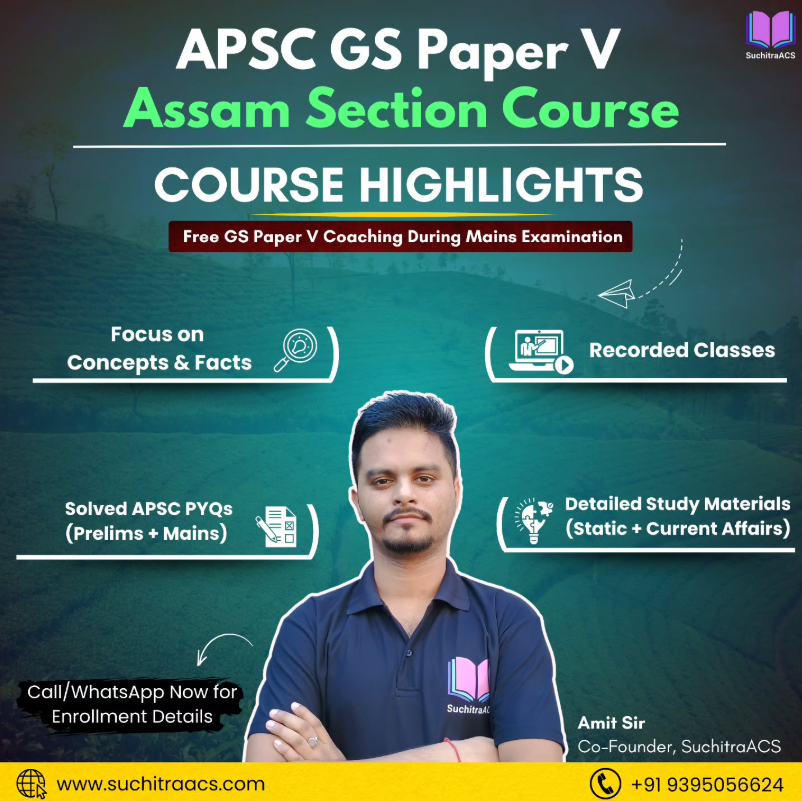

🔔 Join Our WhatsApp Study Group!
For exclusive access to premium quality content, including study materials, current affairs, MCQs, and model answers for APSC CCE and other Assam competitive exams.
Click here to join: SuchitraACS Study WhatsApp Group
📚 Want to know more about SuchitraACS’s most affordable courses?
Click here to know more: SuchitraACS Courses for APSC CCE and Assam Competitive Examinations

